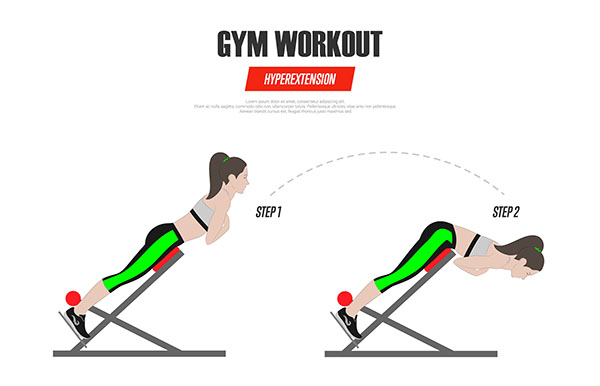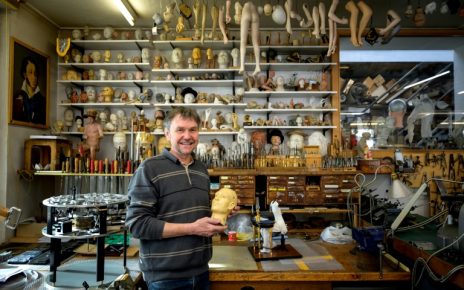Why is a back injury so potentially devastating? It can be summed up in a single word: PAIN! This pain usually begins as a sharp, intense twinge in your lower back and if you’re lucky, it will be only momentary, then immediately disappear without any residual effects. If you’re unlucky, the pain will be sharp, intense (like a twisting knife) and lasting. Sometimes the pain will sneak up on you, and you may not even notice it at first, until it becomes too great to ignore.
The high incidence of back pain and injury is due in large part to the complexity of muscles that are individually incapable of handling the stresses that are transmitted through the back. The forces and torques are transmitted to other tissue (intervertebral discs), which are incapable of handling the stress, and pain results. Although back injury can occur anywhere along the vertebral (spinal) column, sports and training injuries are most frequent in the lower back and the neck (cervical column). These two regions of the spine are the most mobile, and to allow a high degree of movement, they must sacrifice stability. The configuration of one vertebra on the other allows a great deal of forward and backward bending (anterior flexion and posterior extension).
Back Basics
The intervertebral disc sits between adjacent vertebrae and gets squeezed when the spine is flexed or extended. It’s attached to the vertebrae both superior and inferior to it. It bears and distributes excessive motion and is of great mechanical and functional importance. It is well suited for both these roles because of its location between the vertebrae and the unique composition of its inner and outer materials. The intervertebral disc provides a strong attachment between the vertebrae. In fact, much of the movement between adjacent vertebrae takes place over the resilient nucleolus pulposus, the jelly-like inner material of the intervertebral disc that dissipates the forces transmitted to it by expanding. In this way, it acts like a shock absorber in an attempt to minimize impact. The nucleus pulposus is directly in the center of all discs except the lumbar segments, where it is slightly posterior to the center.
A tough outer covering, the annulus fibrosus, surrounds the nucleus pulposus and is made of a tough fibrous cartilage created to form a strong matrix to withstand bending and twisting. The trouble begins when the annulus fibrosus receives a small tear; this allows the nucleus pulposus to leak or protrude from the tear in the disc. This may not be a large problem at first, and you may not even notice anything except for the occasional twinge of pain when the nucleus pulposus touches a nerve exiting from the spinal cord. However, if the disc tear is large, and a higher degree of inner nucleolus pulposus projects from the disc and contacts the nerves, the pain will be intense and severe. Usually rest, traction and/or anti-inflammatory treatments are administered to encourage the leaking nucleus pulposus to return to the center of the disc and stop contact with the nerves. In cases were the nucleus pulposus refuses to cooperate, surgery may be performed to remove the nucleus pulposus from the center of the affected disc by a long needle-like tool.
The lower back (lumbar column) is very susceptible to injury because it’s moveable and has a poor mechanical advantage. This means anytime you bend over from your waist to lift an object, much of the torque caused by the weight of your upper body compounds with the resistance of the weight and sends shearing forces through only two or three vertebrae in the lumbar column (and their corresponding discs). Thus, poor exercise techniques, (jerking, bending over too far during squats, etc.) will only invite injury sooner or later, rather than prevent it. While weak abdominals can contribute to lower back injury largely because they are unable to maintain a strong intra-abdominal pressure to hold the spine in its place, strong abdominals will not be sufficient to counteract weak spinal muscles. Lower back injury can be avoided by improving the flexibility of the hamstring muscles – because tight hamstrings will pull on the pelvis and increase the risk of injury when lifting – and increasing the mass and strength of the muscles that surround the weak links in the lower back.
Lower Back Muscles
The lower back primarily consists of the erector spinae muscles. The thoracolumbar fascia covers these muscles with a tough sheet of string-like connective tissue (fascia) that blends with the origins of the latissimus dorsi muscle. Since this fascia does not have the flexibility of muscle, it’s more prone to injuries from extreme stretching or jerking. The erector spinae lie just deep to this fascial covering.
The erector spinae muscle group is constructed from three muscles. The iliocostalis muscle is the most lateral of the group. It arises from the iliac crest (part of the hip bone), runs superiorly (toward the head) and inserts into the ribs. Some of its fibers will insert into the vertebrae of the neck. The intermediate muscle of the erector spinae group is the longissimus muscle. It runs almost the entire length of the back. Its fibers arise from the lateral bony projections of the vertebrae called transverse processes and insert on more superior transverse processes of the vertebrae. The spinalis muscle is the most medial column of the erector spinae and essentially runs up the center of the back. Specifically, it arises from the spinous processes (small projections in the center of the vertebrae) in the lumbar and lower thoracic regions and insert into the spinous process of the superior portion of the thoracic and neck (cervical) regions.
Collectively, the erector spinae group is the strongest extenders of the vertebral column. Acting on one side of the body at a time, each of these muscles can bend the vertebral column laterally (e.g., in side bends). The three erector spinae muscles can also act to rotate the vertebral column in a twisting action. The iliocostalis is the best rotator of the vertebral column. The remaining two muscles will, however, invoke some rotation along the spine.
Hyperextensions (Lying Back Extensions)
In most back exercises, the axis of rotation involves the hip joint, although there is certainly movement at each of the vertebrae. However, muscles that cross the hip joint, including the powerful gluteal and hamstring muscles, can also affect the movement at this joint and are active during back extension. Still, the erector spinae group acts as the primary movers, extending the back at the hip, causing the torso to be moved upward and controlling its downward movement.
The lower back can achieve a limited amount of hyperextension of the vertebrae. Such hyperextension occurs when the extension movement goes backward beyond the point where the spine is in a straight line. This is recognized as an “arch” in the lower back. Generally, the “hyper” in back extension exercises should be replaced by only extensions to the point where the lower and upper back makes a straight line. An excessive (hyper) back extension can result in the vertebral discs becoming compressed and the nerves that exit between the vertebrae will achieve the same undesired fate.
Correct Exercise Form
1. Lie facedown on a back extension bench (which might be called the hyperextension bench in your gym). Position yourself with your knees almost (but not quite) straight. The bench pad should be comfortably placed across your pelvis, not on your thighs or abdomen. On most benches, you can place your lower leg under pads or rollers that will anchor you. The pads should be placed between mid-calf and ankle.
2. Lower your upper body toward the floor by bending (flexing) at the waist/hip. Cross your arms and lay them across your chest.
3. Begin with a 90-degree angle between your upper and lower body, then extend your back by lifting the torso until your back is parallel to the floor and there’s a straight line through your back, hips and lower legs. Do not lift higher than this to hyperextend your back. The force should come smoothly (no jerking or fast movements should occur) from your erector spinae muscles.
4. After the extension is complete, slowly reverse your direction and control the descent of the weight of your upper body until it’s just short of the starting position. Repeat. This will maintain tension on the muscles throughout the effort.
Training Tips
If you have a stronger and injury-free lower back, you can place your hands behind your head rather than on your chest. For additional resistance, you can hold a weight in your hands, either across your chest or behind your head. If you put the weight behind your head (the most difficult version), be careful during the placement of the weight so you don’t hit your neck or head. Also, do not pull down on your neck with your hands.
You can induce a little more effort from the erector spinae if you hold your upper body at the top position for two to three seconds in each repetition. Don’t swing your torso upward. Both the up and down phases of each repetition should be slow and controlled.
It’s possible to include a slight twist on the upward movement, as long as the twist is not large and you alternate the twist toward the left foot and the right foot. The twist to the right will tend to cause a greater shortening and contraction of the muscles on the right half of the back, but this will slightly unload the left half of the back. Thus, it’s important that your next twist is to the left on the following repetition for equal development in the back.
Proper breathing will help you during the exercise and will also reduce the potential for risk. Simply inhale before beginning the backward push movement, and hold your breath until you reach the top (full back extension). You may then exhale on the return to the starting position. The full breath on the upward extension will increase the pressure in your rib cage and create a rigid thoracic column. This tends to prevent movement between the vertebrae and thereby, protect the intervertebral discs from compression injuries. However, if you have cardiovascular disease, diabetes or high blood pressure, do not hold your breath during exercise. Simply inhale when going up, and exhale as you lower your body.
Minimize Back Injury
Be aware that the erector muscles of the vertebral column are active in many other exercises. As a result, you should plan your exercise routine very carefully, so the lower back is stressed appropriately and not over-stressed. Also, the erector spinae muscles will only develop the strength needed to minimize back injury if the muscles have been developed with sufficient resistance during both the flexion and extension portions of the movement. However, the serious effort associated with this type of training is far better than the disabling pain that accompanies a neglect-induced injury of the lower back.
References:
Cholewicki J, Juluru K, Radebold A, Panjabi MM and McGill SM. Lumbar spine stability can be augmented with an abdominal belt and/or increased intra-abdominal pressure. Eur Spine J 8: 388-395, 1999.
Clemente CD. Anatomy, A regional atlas of the human body. Second edition, Baltimore, Urban & Schwarzenberg Pub. Co. 1981, pp. 33-75.
Kumar S and Narayan Y. Spectral parameters of trunk muscles during fatiguing isometric axial rotation in neutral posture. J Electromyogr Kinesiol 8: 257-267, 1998.
Kumar S, Narayan Y and Garand D. Isometric axial rotation of the trunk in the neutral posture. Eur J Appl Physiol 86: 53-61, 2001.
McGill SM, Hughson RL and Parks K. Lumbar erector spinae oxygenation during prolonged contractions: implications for prolonged work. Ergonomics 43: 486-493, 2000.
Norkin CC and PK Levangie. Joint Structure and Function. A Comprehensive Analysis FA Davis Co., Philadelphia, Chpt. 4 Vertebral Column, 1992, pp. 125-169
Plamondon A, Marceau C, Stainton S and Desjardins P. Toward a better prescription of the prone back extension exercise to strengthen the back muscles. Scand J Med Sci Sports 9: 226-232, 1999.
Rasch PJ Kinesiology and Applied Anatomy, Seventh edition. Philadelphia, London. Lea & Febiger, 1989, pp. 117-120.
The post Lower Back Pain: Any Relief? first appeared on FitnessRX for Women.






